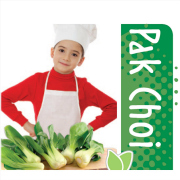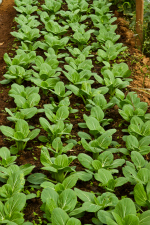Pak choi is from the cabbage family and is used in lots of Asian dishes. It has other names as well including ‘bok choy’ or ‘Chinese white cabbage’. It has thick, glossy stems with large green leaves which grow upright from the base to form one whole vegetable.
It is best to grow pak choi in milder weather because it can ‘bolt to seed’ in hot dry summers. This is when it sends up a flowering stem from the centre and then the rest of the plant starts to turn bitter and change shape.
PLANTING
Before planting, remove weeds from the garden bed and dig through lots of compost or organic manure. Water the soil lightly and then use a dibbler or large stick to make holes 20cm apart. Place a seedling in each and gently push the soil around the root system. Water again.
Pak choi is easy to grow in pots that are at least 25cm deep. Simply fill them with premium potting mix, plant the seedlings and water them well. Make sure the pots get at least six hours of direct sunlight.
CARE AND MAINTENANCE
Water pak choi every day, especially if the weather is hot and apply a liquid fertiliser every two weeks.
Keep an eye out for snails, cabbage white butterfly and aphids which might eat them before you do. To find out how to deal with these pests, visit the Bag Bugs section of our website.
HARVESTING
If pak choi is harvested when it is quite young, it’s called ‘baby pak choi’ but it is also possible to leave them in the ground to grow until they are a larger size.
Just the outer leaves of a pak choi can be harvested leaving the rest of the plant to keep growing but if all of the vegetable is wanted, pull it out of the ground and use a knife to cut off the roots which can go into the compost.
Wash the pak choi well before serving as dirt can get between the stems.
HOW TO EAT
Both the stems and the leaves of pak choi can be eaten. Baby pak choi look fantastic when served whole after being steamed or microwaved for just a minute or two so that the stems are still crunchy.
The leaves of pak choi can be separated from each other and steamed or microwaved and then served with a little salt and pepper. Or, if cooking a stir fry, cut the stems into slices and leave the leaves whole. Then, throw the stems into the wok earlier so that they can cook and then put the leaves in at the last minute as they don’t need much heat to warm them through.
Find some great recipes in the Smarty Plants Kitchen.
HOW THEY GROW
Pak choi are from the same family as cabbages and grow in a similar way. Thick white stems grow from the base which is at ground level and a large green leaf grows at the top of each stem.
FAST FACTS
Botanical Name: Brassica rapa var. chinensis
Life Cycle: Annual
When to Grow: Can be grown all year round but avoid very hot, dry months.
Height/Width: 25cm x 20cm.
Requirements: Plant in full sun and water every day unless it rains. Liquid fertilise fortnightly.
Nutritional Benefits: Excellent source of vitamin C but also contains iron and calcium.


